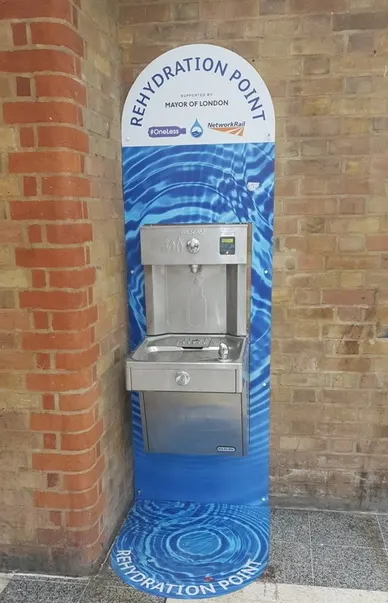One of the first things I noticed when I moved to the UK, is that the bathrooms have two taps. It’s an odd thing to pick up on but I guess when you are used to having mixed taps in your home country its something you need to get used to.
This is why English homes have two taps – In the UK, there’s a law that prohibits mixing cold water and hot water from their separate boilers, one for cold water in the attic for drinking and one for hot water downstairs which is not drinkable.
Using London as an example, and with a little detective work, we can create a picture of how London’s water system was developed, along with major issues involved, in the last few hundred years. This will answer the question of how they ended up with two faucets.
Disclaimer: Hi! this post may contain affiliate links which will take you to online retailers that sell products and services. If you click on one and buy something, I may earn a commission, see my Affiliate Disclosure for more details.
Why do UK Houses Have Water Tanks?
The reason for the two water tanks is to prevent any used cleaning water from the house (possibly contaminated) flowing back into the cold drinking water.
How to use British taps
There are really only two simple methods:
- Plug the sink, fill it with both hot and cold water to get to your preferred temperature, and then wash in this water.
- Open both taps at the same time, move your hands really fast between both of them and, if you do it quickly enough, you can sort of get the water mixed.
Why are Cold Taps on the Right?
The simple answer to this question is that most people are right–handed, and the cold tap is used the most. So, therefore, the hot tap is on the left.
Where does London’s Drinking Water Come From?

The majority of London’s drinking water, almost 70% in total, is retrieved from reservoirs outside the city, which have collected water directly from the Thames River.
After being treated at facilities to ensure removal of any harmful elements, it is transported through one mammoth feeder pipe to smaller reservoirs around the city’s perimeter, after which it is fed through a web of piping directly to residential homes and building throughout London.
So, what about the remaining 30% of drinking water? This is the other percentage of drinking water which is retrieved from boreholes that access groundwater directly and pump it to the surface. It then goes through the same treatment and pipe system and combines to reach the city.
On a typical day in London, this water system provides over 2,100 million litres of drinking water, which doubles during hot spells.
How is London’s Sewer Water Treated?
When you flush a toilet or drain your sink, the used water goes down a drainpipe and travels out into the larger system of sewer pipes under the roads of London.
Local sewers then join a larger web of sewer pipes and wastewater finally reaches to a sewage treatment facility – sometimes by drainage and sometimes by pumping.
Then the first stage of purifying wastewater involves removing large objects that could damage equipment or present pollution to local waterways.
After this separation, wastewater still contains organic solid matter, meaning human waste. The following stage separates this solid waste from the remaining water. This is done by pumping the water into large settlement tanks, where it settles for a determined amount of time. Separation occurs during this process, which causes the solids to sink to the bottom of the tank.
At this stage, even though the visible bits of sludge and solid waste have been removed, it is still most important to ensure that the smaller and sometimes invisible nasty bugs are also taken out.
After that second treatment, the final wastewater is then passed through the last settlement tank, where the good bacteria sink to the bottom. In the end, the final clean water is pumped over a separation wall near the top of the tank and out into the waterways.
Residential Plumbing Design in London
England has had a long and rich history with all things related to the bathroom. There are still unused sewers from the Romans underground, as well as visible remnants of Roman walls above ground.
Bathhouses used to be in operation along the Thames River until the fifteenth century, then individual bathrooms began as early as the 1700s and evolved into elaborate bathrooms by the Victorian Period in the late 1800s.
Another all-important device was invented in England at this time by Thomas Crapper, which represented another function of water use that needed to be addressed.
It’s obvious that, by the 1800s, Londoners required both hot and cold water daily in their own homes. Plumbing pipes, water heaters, and fixtures accommodated this starting then and continuing to the present.
However, with London’s unhealthy past related to drinking water and wastewater, a case could be made that Brits prefer two taps and separate water tanks to ensure they will never have to deal with water-related illnesses again.
Short History of UK Residential Water
The real boom of innovative water companies providing water to London’s residential districts took place in the 1700s and 1800s. There was a boom in modernization as homeowners demanded clean and ultra-convenient water for their families and the upgrade efforts were led by the New River Water Company, the London Bridge Waterworks, and others.
Borough by borough, this transformation occurred, with some of the last areas like Kensington and Chelsea added to the system during the nineteenth century. However, in parallel with the push for convenient drinking water, major problems had developed with the sewage system.
London is well-known for having water sewage issues a mere century earlier in the 1600s, with the black plague being traced to the water system and killed an estimated 100,000 people. So, it was incredibly important to determine the current causes of foul-smelling sewage water that gave such a bad reputation to the city and the River Thames around which it is built.
Joseph Bazalgette, a civil engineer and expert with water systems, was engaged to take on the huge task of planning and building a new sewer system for the city of London. Constructed during the mid-1800s, the new sewer system pulled used water from London’s homes and buildings and fed them out through major waterways.
This building project was truly on a mammoth scale and almost equal to a “world wonder.” To understand the scope of this building effort, here are some statistics:
- Six interceptor sewers needed building, covering 100 miles
- These were fed by 450 miles of main sewers
- These were fed by 13,000 miles of local street sewers
- 318 million bricks were used in the building process
- 670,000 cubic meters of concrete was used to build
- 2.7 million cubic meters of land were excavated
The entire sewer system was designed and built in such and practical manner, that it left hundreds of miles underground for the eventual construction of London’s famous and highly efficient Underground train system, similar to New York’s subways but cleaner.

Kat
Hi, I'm Kat, an Australian that moved to London in 2013 to start a new adventure. What a roller-coaster that was! I love helping others move to the UK and people explore the world! I’d be honoured if you’d say, “Thanks!” with a £3 coffee on Ko-fi.

